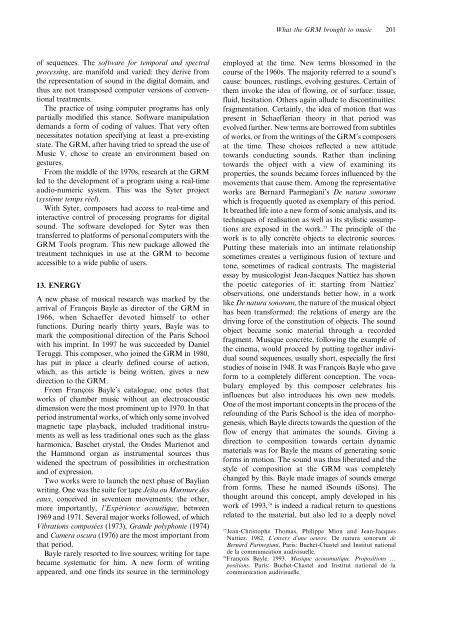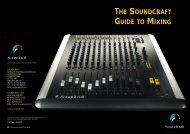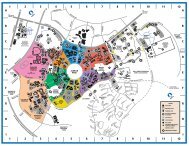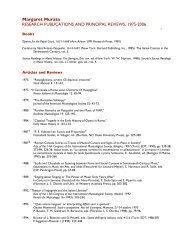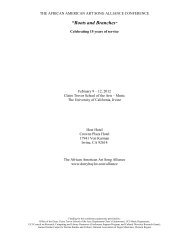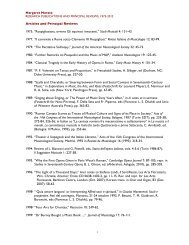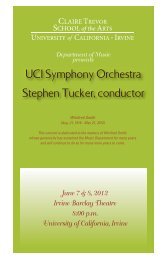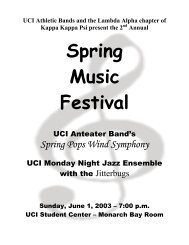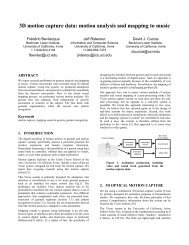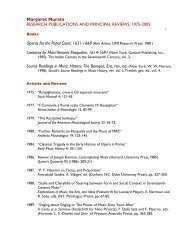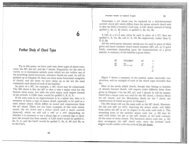200 Marc BattierThe development of a device for electronic productionwas <strong>the</strong> responsibility of François Coupigny, 71 whodirected <strong>the</strong> Group for Technical Research. Coupignyproduced an ensemble of electronic modules designed <strong>to</strong>generate signals and <strong>to</strong> process external sources. Thesedevices emerged in about 1969. Thereafter called <strong>the</strong>syn<strong>the</strong>siser (a term which at <strong>the</strong> beginning <strong>the</strong>y had tried<strong>to</strong> avoid because it had a meaning that linked it <strong>to</strong>electronic <strong>music</strong>), it became <strong>the</strong> heart of <strong>the</strong> new Studio54 at <strong>the</strong> <strong>GRM</strong>; installed by Henri Chiarucci in 1970,conveniently set up above <strong>the</strong> nerve centre of <strong>the</strong> studio,<strong>the</strong> mixing console furnished <strong>the</strong> tape recorders withremote controls. It served also as a model for a moremodest but portable unit, used for concerts up <strong>to</strong> <strong>the</strong>present day. It was in this way that <strong>the</strong> compositionalenvironment of <strong>the</strong> <strong>GRM</strong> <strong>to</strong>ok <strong>the</strong> same path as o<strong>the</strong>rstudios in <strong>the</strong> world, namely that of au<strong>to</strong>mation. Thistendency began with <strong>the</strong> cybernetic inventions of Louisand Bebe Barron in New York, and includes o<strong>the</strong>rs suchas Raymond Scott’s electronium (United States), Josef-An<strong>to</strong>n Riedl’s Siemens studio in Germany, <strong>the</strong> BelgianIPEM studio in Ghent, and <strong>the</strong> Dutch studio in Utrecht.The <strong>GRM</strong> way of composing in part depended on <strong>the</strong>technological environment in which it was deployed. Wehave seen how <strong>the</strong> experience of microphone recordingcan lead <strong>to</strong> a particular listening experience, and howthis act was relayed by <strong>the</strong> devices and machinesinvented for composition.Under <strong>the</strong>se conditions, <strong>the</strong> question of <strong>music</strong>alnotation was posed in a way that had not been made uptill <strong>the</strong>n, as <strong>the</strong> realisation of <strong>music</strong> had depended on <strong>the</strong>employed production techniques. There are only a veryfew examples of prescriptive notation in <strong>the</strong> ParisSchool tradition. Schaeffer, in his first experiences, hadtried <strong>to</strong> note his figures of concrète objects for his firstétude, but this tentative experiment was quicklyabandoned. It flows <strong>from</strong> his <strong>the</strong>ory of <strong>the</strong> primacy of<strong>the</strong> ear that <strong>the</strong> work should be composed as close aspossible <strong>to</strong> <strong>the</strong> material, and given that no instrumentalistis required, notation is of little utility. In <strong>the</strong> courseof training young composers, Schaeffer would askstudents <strong>to</strong> make études, stemming <strong>from</strong> schemes inwhich <strong>the</strong> types of objects <strong>to</strong> be used were specified. Themost developed notation is that which offers visualmarks for <strong>the</strong> diffusion of works. François Bayle’sconcept of <strong>the</strong> acousmonium in 1974 hastened <strong>the</strong> usageof notation: graphics, imposed upon a temporal axis,allowed <strong>the</strong> diffusion of sounds at <strong>the</strong> heart of thisorchestra of sound projec<strong>to</strong>rs. For <strong>the</strong> Paris School,notation was not something <strong>to</strong> be inscribed in <strong>the</strong>conception but in <strong>the</strong> gesture. Even with <strong>the</strong> arrival ofcomputer technology, which forces one <strong>to</strong> specify exact71Francis Coupigny. 2001. ‘Sous la direction de Pierre Schaeffer:repères pour un parcours inventif’. In Sylvie Dallet and AnneVeitl (eds) Du sonore au <strong>music</strong>al, Paris: L’Harmattan, pp. 55–60.data, <strong>the</strong> gesture remained a focus with <strong>the</strong> creation of<strong>the</strong> Syter digital machine.But how did <strong>the</strong> <strong>GRM</strong> welcome <strong>the</strong> arrival ofcomputers? The development of digital <strong>music</strong> in Europewas late and very gradual. The <strong>GRM</strong> was amongst <strong>the</strong>first <strong>to</strong> invest in this novel and still somewhatinaccessible technology. It fell <strong>to</strong> Francis Régnier <strong>to</strong>explore <strong>the</strong> possibilities, despite <strong>the</strong> extreme cautionattached <strong>to</strong> it by Schaeffer ever since 1970.During that period, <strong>the</strong> most developed software fordigital syn<strong>the</strong>sis and processing was Music V, anapplicationinwidespreaduse,developedat<strong>the</strong>BellTelephone Labora<strong>to</strong>ries by Max Ma<strong>the</strong>ws and histeam. 72 Jean-Claude Risset played his part in this. Hewas <strong>the</strong> first <strong>to</strong> introduce it later in France, at <strong>the</strong>Université d’Orsay. The program was placed at <strong>the</strong>disposal of <strong>the</strong> <strong>GRM</strong> on a mini-computer. Thiscomputer system was installed in <strong>the</strong> little Studio 123at <strong>the</strong> Maison de la radio, which was near Studio 116,dedicated <strong>to</strong> conventional analogue techniques.The first attempt <strong>to</strong> distribute Music V among <strong>the</strong>composers of <strong>the</strong> <strong>GRM</strong> failed. Seeing that it wasnecessary <strong>to</strong> predetermine <strong>the</strong> data and code thingsexactly, <strong>the</strong> <strong>music</strong>ians could not find <strong>the</strong> equivalent of<strong>the</strong> gesture. The answer <strong>to</strong> this setback was found in <strong>the</strong>development of digital programs conceived <strong>to</strong> emulateconventional processing of sounds. The goal was thus <strong>to</strong>attempt <strong>to</strong> reproduce in software <strong>the</strong> manipulations of<strong>the</strong> analogue studio so that composers would find<strong>the</strong>mselves in familiar terri<strong>to</strong>ry. Bénédict Mailliard, inStudio 123, <strong>the</strong>n defended <strong>the</strong> idea of a conversationaltype of programme. With this class of software <strong>the</strong> usercould choose <strong>the</strong> values of transposition and display<strong>the</strong>m as variables similar <strong>to</strong> conventional machines. Onecalls this conversational because <strong>the</strong> software establishesa dialogue with <strong>the</strong> <strong>music</strong>ian and <strong>the</strong> latter respondsaccording <strong>to</strong> those choices that seem good <strong>to</strong> him. He<strong>the</strong>refore works on an interface which, in <strong>the</strong> background,steers a number of processing programmes. The‘set of resonant filters’ deserves a special mention,because it became one of <strong>the</strong> most attractive <strong>to</strong>ols andbecause it represents an original contribution <strong>to</strong> digitalmanipulation. The filters allow sounds <strong>to</strong> pass throughadjustable frequency bands up <strong>to</strong> a level where <strong>the</strong>filter itself resonates and accompanies <strong>the</strong> treated soundwith a sort of spectral reverberation. Besides that, <strong>the</strong><strong>music</strong>ian can freely choose <strong>the</strong> number of filters makingup <strong>the</strong> treatment set, as it is software-based and <strong>the</strong> onlylimits are those of <strong>the</strong> machine: <strong>the</strong> gesture now takesplace in <strong>the</strong> virtual domain. One can hear this applied in<strong>the</strong> first work that came out of Studio 123, Erosphère byFrançois Bayle. The sound edi<strong>to</strong>r res<strong>to</strong>res <strong>the</strong> operationsof editing in <strong>the</strong> digital domain – segmentation, collage72Max V. Ma<strong>the</strong>ws, with <strong>the</strong> collaboration of Joan E. Miller, F.Richard Moore, John R. Pierce and Jean-Claude Risset. 1969.The Technology of Computer <strong>music</strong>, Cambridge, Mass.: The MITPress.
<strong>What</strong> <strong>the</strong> <strong>GRM</strong> <strong>brought</strong> <strong>to</strong> <strong>music</strong> 201of sequences. The software for temporal and spectralprocessing, are manifold and varied: <strong>the</strong>y derive <strong>from</strong><strong>the</strong> representation of sound in <strong>the</strong> digital domain, andthus are not transposed computer versions of conventionaltreatments.The practice of using computer programs has onlypartially modified this stance. Software manipulationdemands a form of coding of values. That very oftennecessitates notation specifying at least a pre-existingstate.The<strong>GRM</strong>,afterhavingtried<strong>to</strong>spread<strong>the</strong>useofMusic V, chose <strong>to</strong> create an environment based ongestures.From <strong>the</strong> middle of <strong>the</strong> 1970s, research at <strong>the</strong> <strong>GRM</strong>led <strong>to</strong> <strong>the</strong> development of a program using a real-timeaudio-numeric system. This was <strong>the</strong> Syter project(système temps réel).With Syter, composers had access <strong>to</strong> real-time andinteractive control of processing programs for digitalsound. The software developed for Syter was <strong>the</strong>ntransferred <strong>to</strong> platforms of personal computers with <strong>the</strong><strong>GRM</strong> Tools program. This new package allowed <strong>the</strong>treatment techniques in use at <strong>the</strong> <strong>GRM</strong> <strong>to</strong> becomeaccessible <strong>to</strong> a wide public of users.13. ENERGYA new phase of <strong>music</strong>al research was marked by <strong>the</strong>arrival of François Bayle as direc<strong>to</strong>r of <strong>the</strong> <strong>GRM</strong> in1966, when Schaeffer devoted himself <strong>to</strong> o<strong>the</strong>rfunctions. During nearly thirty years, Bayle was <strong>to</strong>mark <strong>the</strong> compositional direction of <strong>the</strong> Paris Schoolwith his imprint. In 1997 he was succeeded by DanielTeruggi. This composer, who joined <strong>the</strong> <strong>GRM</strong> in 1980,has put in place a clearly defined course of action,which, as this article is being written, gives a newdirection <strong>to</strong> <strong>the</strong> <strong>GRM</strong>.From François Bayle’s catalogue, one notes thatworks of chamber <strong>music</strong> without an electroacousticdimension were <strong>the</strong> most prominent up <strong>to</strong> 1970. In thatperiod instrumental works, of which only some involvedmagnetic tape playback, included traditional instrumentsas well as less traditional ones such as <strong>the</strong> glassharmonica, Baschet crystal, <strong>the</strong> Ondes Martenot and<strong>the</strong> Hammond organ as instrumental sources thuswidened <strong>the</strong> spectrum of possibilities in orchestrationand of expression.Two works were <strong>to</strong> launch <strong>the</strong> next phase of Baylianwriting. One was <strong>the</strong> suite for tape Jeîta ou Murmure deseaux, conceived in seventeen movements; <strong>the</strong> o<strong>the</strong>r,more importantly, l’Expérience acoustique, between1969 and 1971. Several major works followed, of whichVibrations composées (1973), Grande polyphonie (1974)and Camera oscura (1976) are <strong>the</strong> most important <strong>from</strong>that period.Bayle rarely resorted <strong>to</strong> live sources; writing for tapebecame systematic for him. A new form of writingappeared, and one finds its source in <strong>the</strong> terminologyemployed at <strong>the</strong> time. New terms blossomed in <strong>the</strong>course of <strong>the</strong> 1960s. The majority referred <strong>to</strong> a sound’scause: bounces, rustlings, evolving gestures. Certain of<strong>the</strong>m invoke <strong>the</strong> idea of flowing, or of surface: tissue,fluid, hesitation. O<strong>the</strong>rs again allude <strong>to</strong> discontinuities:fragmentation. Certainly, <strong>the</strong> idea of motion that waspresent in Schaefferian <strong>the</strong>ory in that period wasevolved fur<strong>the</strong>r. New terms are borrowed <strong>from</strong> subtitlesof works, or <strong>from</strong> <strong>the</strong> writings of <strong>the</strong> <strong>GRM</strong>’s composersat <strong>the</strong> time. These choices reflected a new attitude<strong>to</strong>wards conducting sounds. Ra<strong>the</strong>r than inclining<strong>to</strong>wards <strong>the</strong> object with a view of examining itsproperties, <strong>the</strong> sounds became forces influenced by <strong>the</strong>movements that cause <strong>the</strong>m. Among <strong>the</strong> representativeworks are Bernard Parmegiani’s De natura sonorumwhich is frequently quoted as exemplary of this period.It brea<strong>the</strong>d life in<strong>to</strong> a new form of sonic analysis, and itstechniques of realisation as well as its stylistic assumptionsare exposed in <strong>the</strong> work. 73 The principle of <strong>the</strong>work is <strong>to</strong> ally concrète objects <strong>to</strong> electronic sources.Putting <strong>the</strong>se materials in<strong>to</strong> an intimate relationshipsometimes creates a vertiginous fusion of texture and<strong>to</strong>ne, sometimes of radical contrasts. The magisterialessay by <strong>music</strong>ologist Jean-Jacques Nattiez has shown<strong>the</strong> poetic categories of it: starting <strong>from</strong> Nattiez’observations, one understands better how, in a worklike De natura sonorum, <strong>the</strong> nature of <strong>the</strong> <strong>music</strong>al objecthas been transformed: <strong>the</strong> relations of energy are <strong>the</strong>driving force of <strong>the</strong> constitution of objects. The soundobject became sonic material through a recordedfragment. Musique concrète, following <strong>the</strong> example of<strong>the</strong> cinema, would proceed by putting <strong>to</strong>ge<strong>the</strong>r individualsound sequences, usually short, especially <strong>the</strong> firststudies of noise in 1948. It was François Bayle who gaveform <strong>to</strong> a completely different conception. The vocabularyemployed by this composer celebrates hisinfluences but also introduces his own new models.One of <strong>the</strong> most important concepts in <strong>the</strong> process of <strong>the</strong>refounding of <strong>the</strong> Paris School is <strong>the</strong> idea of morphogenesis,which Bayle directs <strong>to</strong>wards <strong>the</strong> question of <strong>the</strong>flow of energy that animates <strong>the</strong> sounds. Giving adirection <strong>to</strong> composition <strong>to</strong>wards certain dynamicmaterials was for Bayle <strong>the</strong> means of generating sonicforms in motion. The sound was thus liberated and <strong>the</strong>style of composition at <strong>the</strong> <strong>GRM</strong> was completelychanged by this. Bayle made images of sounds emerge<strong>from</strong> forms. These he named iSounds (iSons). Thethought around this concept, amply developed in hiswork of 1993, 74 is indeed a radical return <strong>to</strong> questionsrelated <strong>to</strong> <strong>the</strong> material, but also led <strong>to</strong> a deeply novel73Jean-Chris<strong>to</strong>phe Thomas, Philippe Mion and Jean-JacquesNattiez. 1982. L’envers d’une oeuvre. De natura sonorum deBernard Parmegiani, Paris: Buchet-Chastel and Institut nationalde la communication audivisuelle.74François Bayle. 1993. Musique acousmatique. Propositions …positions. Paris: Buchet-Chastel and Institut national de lacommunication audivisuelle.


